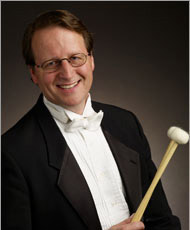by Daniel Hathaway
 The first weekend of the third year of Dutch conductor Ton Koopman’s productive residency with The Cleveland Orchestra gave Severance Hall audiences a new perspective on three Viennese classical works by Mozart and Haydn, introduced a French baroque descriptive piece by a composer the orchestra has never tackled before, and brought a true novelty to light: a late eighteenth century showpiece starring timpanist Paul Yancich.
The first weekend of the third year of Dutch conductor Ton Koopman’s productive residency with The Cleveland Orchestra gave Severance Hall audiences a new perspective on three Viennese classical works by Mozart and Haydn, introduced a French baroque descriptive piece by a composer the orchestra has never tackled before, and brought a true novelty to light: a late eighteenth century showpiece starring timpanist Paul Yancich.
To be precise, only half of The Cleveland Orchestra was playing on the East side of East Boulevard on Saturday evening, May 4 — the rest of the musicians had been involved all week with the two-concert series “California Masterworks” at the Cleveland Museum of Art. For Mozart’s Symphony No. 1 in E-flat, the Severance stage was set up for a period-sized ensemble of fifteen violins, six violas, four cellos and four basses, and pairs of oboes and horns.
Whether or not K. 16 is really Mozart’s first symphony, the precocious youngster wrote the piece in London at the age of eight and managed to trump the largely vacuous symphonies of the Mannheim School. The symphony, estimated to last about fifteen minutes but which Koopman brought home in nine, picks up elements of opera buffa and hunting music in its outside movements and spins out a long Andante. Mozart was twice as old when he wrote his twice-as-long Symphony in G, No. 17, K. 129, but the structure of three movements (Fast-Slow-Fast) hadn’t changed, and the final movement is still in the form of a chasse. Koopman shaped graceful performances suffused with energy and clarity, with string vibrato turned off for the evening.
Between the Mozart symphonies came Johann C.C. Fischer’s Symphony with Eight Obbligato Timpani. The composer is obscure, and we have no idea for what obviously ceremonial occasion the piece was written, but it’s an arresting curiosity which became an expressive piece of music in the expert hands of principal timpanist Paul Yancich. Positioned stage right of the podium and flanked by trumpets and oboes, Yancich found the different sweet spots on his eight drums with the adroitness of a musical octopus, playing an amazingly melodic cadenza and sometimes doubling the oboe line octaves lower to surprising effect. Though the piece sounds as though it would be noisy and military, it’s actually gentle and stately in performance and garnered Yancich a well-deserved standing ovation.
After intermission, pairs of flutes, oboes, horns, trumpets and bassoon, drum and harpsichord joined the strings for another curiosity — Jean-Féry Rebel’s 1737 Chaos from Les Éléments, not unfamiliar to early music audiences but a complete newbie to The Cleveland Orchestra and Severance Hall. What fun it must have been for a composer during the Enlightenment, when the Universe was thought of as a well-oiled clock, to try to smash everything up in a musical depiction of chaos. Haydn did that at the beginning of The Creation, but that seems mild by comparison to Rebel’s astonishing prelude to a spectacle celebrating the four elements, earth, air, fire and water. It’s truly frightening, a feeling that lingers even after order has been restored. By the time Chaos came around on the program, ears had adjusted to more intimate sound levels, making Koopman and the Orchestra’s initial chord (all the pitches of a minor scale) seem all the more earth-shattering.
The finale of this interesting and engaging concert — it couldn’t have been anything but the last work — was Haydn’s Symphony No. 45 in f-sharp, “Farewell”. The Cleveland Orchestra routinely plays Haydn superbly but on this occasion contrasts seemed sharper, melodic lines more inflected and surging, and the pace of the proceedings more sprightly. Of course, everybody was waiting to see what would happen in the final Adagio, an Esterházy labor action in the form of a minuet. Musicians’ retreat from the stage began slowly with one or two and increased to a gradual exodus accompanied by some amusing body language. Finally, down to two fiddles, Koopman seemingly threw the towel in and stalked off to a big laugh. When the abandoned pair too crept off, stage lights went to black. Then all filed back on for a bow and an ovation.
Published on ClevelandClassical.com May 14, 2013
Click here for a printable version of this article.



